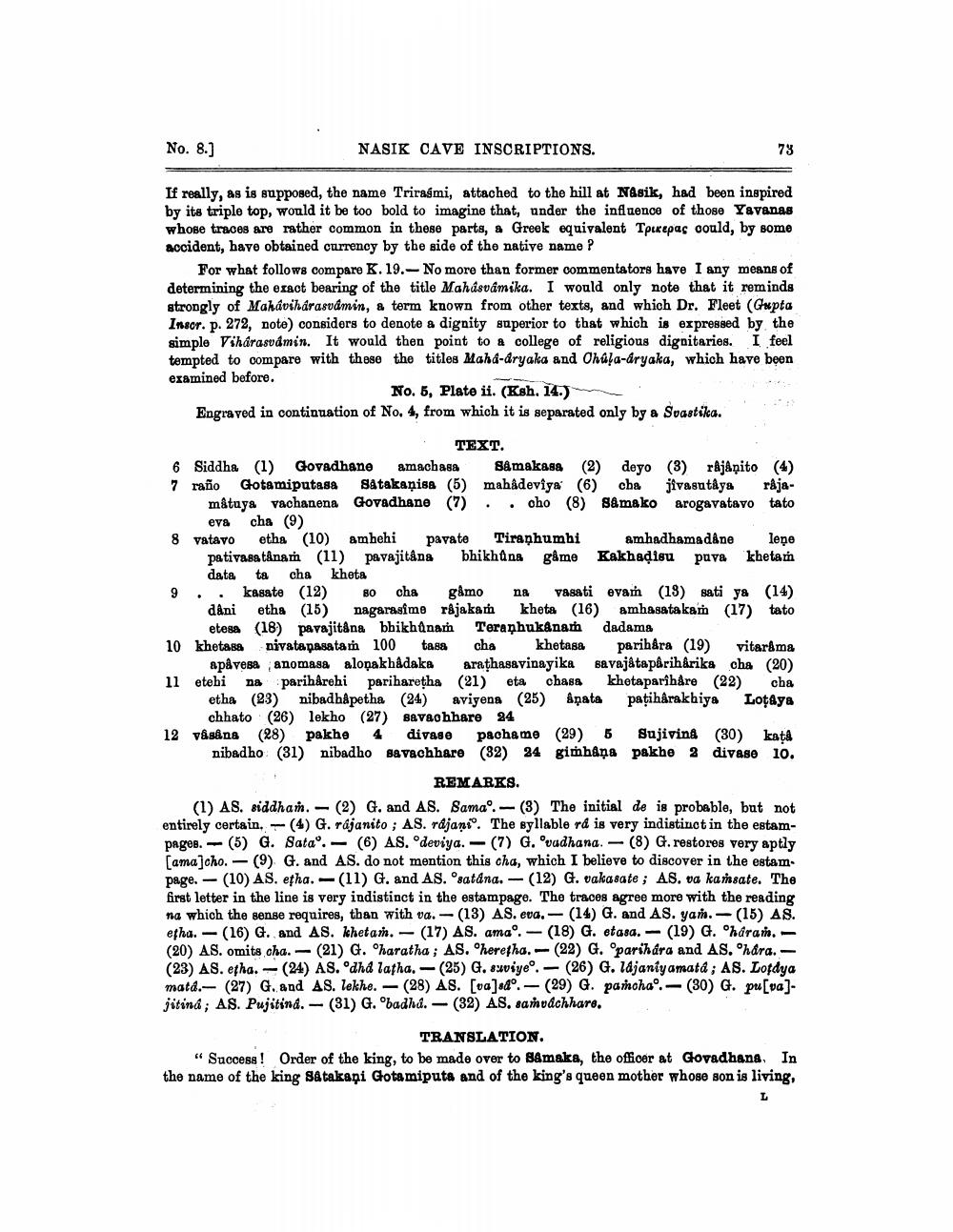________________
No. 8.]
NASIK CAVE INSCRIPTIONS.
78
If really, as is supposed, the name Trirasmi, attached to the hill at Nasik, had been inspired by its triple top, would it be too bold to imagine that, under the influence of those Yavanas whose traces are rather common in these parts, a Greek equivalent Tpurepas could, by some accident, have obtained currency by the side of the native name?
For what follows compare K. 19.- No more than former commentators have I any means of determining the exact bearing of the title Mahásvámika. I would only note that it reminds strongly of Mahavihárasvamin, & term known from other texts, and which Dr. Fleet (Gupta Insor. p. 272, note) considers to denote a dignity superior to that which is expressed by the simple Vihärasvdmin. It would then point to a college of religious dignitaries. I feel tempted to compare with these the titles Mahd-dryaka and Chala-dryaka, which have been examined before.
No. 5, Plate ii. (Ksh. 14.) Engraved in continuation of No. 4, from which it is separated only by a Svastika.
TEXT. 6 Siddha (1) Govadhane amachasa Samakasa (2) deyo (3) rájanito (4) 7 raño Gotamiputasa Satakanisa (5) mahadeviya (6) cha jivasutâys råja
måtuya Vachanena Govadhane (7) . .cho (8) Samako arogavatavo tato
eva cha (9) 8 vatayo etha (10) amhehi pavate Tiraņhumhi mhadhamadane leņe
pativasatånar (11) pavajitâna bhikhûna gåme Kakhadisu pavakhetan
data ta cha kheta 9 .. kasate (12) 0 cha gåmo na vasati ovam (18) sati ya (14)
danietha (15) nagarasime rajakan kheta (16) ambasata kam (17) tato
etega (18) pavajitâna bhikhunań Teraņhukanam dadama 10 khetasa nivatapasatan 100 tasa cha khetasa parihåra (19) vitarama
apåvesa anomasa alopakhadaka arathasavinayika bavajatapariharika cha (20) 11 etebi na parihårehi pariharetha (21) eta chasa khetaparihåre (22) cha
etha (23) nibadhåpetha (24) avijena (25) amata pațihârakhiya Lotaya
chhato (26) lekho (27) Bavao hhare 24 12 vågåna (28) pakhe 4 divase pachame (29) 5 Sujiving (30) kata nibadho (31) nibadho Bavachhare (32) 24 gimhaņa pakhe 2 divase 10.
REMARKS. (1) AS, siddhan. - (2) G. and AS. Sama'.-(3) The initial de is probable, but not entirely certain. -- (4) G. rájanito; AS. rajans'. The syllable rd is very indistinct in the estampages. (5) G. Sata'. - (6) AS. "deviya. -(7) G. vadhana. -(8) G. restores very aptly [ama]cho. — (9) G. and AS, do not mention this cha, which I believe to discover in the estampage. - (10) AS. etha. -(11) G. and AS. osatana. -(12) G. vakasate ; AS. va kansate. The first letter in the line is very indistinct in the estampage. The traces agree more with the reading na which the sense requires, than with va. -(13) AS. eva. - (14) G. and AS. yan. -(15) AS. etha. - (16) G. and AS. Ichetan. — (17) AS. amao. - (18) G. etasa. -(19) G. Charan. - (20) AS. omits cha. -(21) G. Charatha; AS. 'heretha. -(22) G. parihara and AS. "hara. - (23) AS. etha. -(24) AS.dhd latha. -(25) G. swiye'. - (26) G. ldjaniyamata ; AS. Lofdya mata.- (27) G. and AS. lekhe. - (28) AS. [va)odo. - (29) G. pamcha'.-(30) G. pu[va]jitina; AS. Pujitind. - (31) G. 'badhd. - (32) AS, sanvachhare.
TRANSLATION. "Success! Order of the king, to be made over to samaka, the officer at Govadhana. In the name of the king S&takani Gotamiputa and of the king's queen mother whose son is living,




